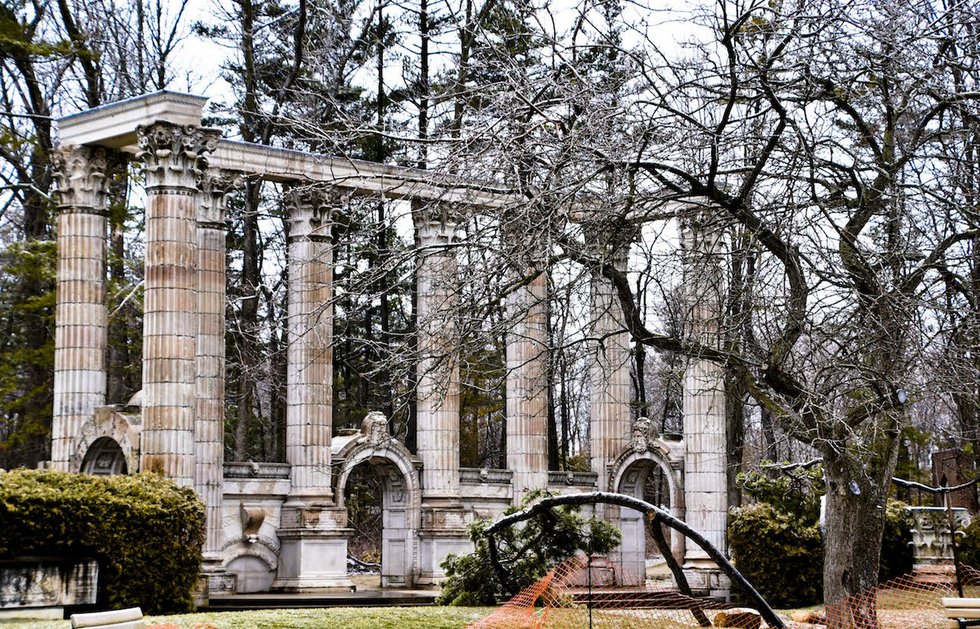
When Ontario Premier John Robarts cut the ribbon at the formal opening on May 13, 1968 of the Toronto-Dominion Centre’s two black towers, the timing was fortuitous. Less than six weeks earlier, humanoids of an imagined future made first contact with a mysterious black monolith in the premiere of Stanley Kubrick’s 2001: A Space Odyssey.
In Don Mills, construction of Raymond Moriyama’s Ontario Science Centre would not be completed until 1969, and Eb Zeidler’s Ontario Place, the city’s most Expo-like structure, not until 1971. But downtown, where the only high buildings were Commerce Court and the Royal York Hotel, the two colossal structures of 56 and 46 storeys completed in 1967, in black-painted steel and bronze-tinted glass, rose like arrivals from another world over the city’s core.
What caused this marvel?
When the Dominion Bank and the Bank of Toronto merged in 1955, it was determined that a new Toronto-Dominion bank would replace the majestic Beaux-Arts Bank of Toronto. Where it needed only seven storeys of floor space, TD would build a total of 102, convinced that where it built, it would grow and others would come.
Developer William Zeckendorf proposed the largest concrete building in the British Commonwealth. Toronto-Dominion president Allen Lambert rejected it and turned instead to Fairview, the real estate arm of realtor and whisky magnate Sam Bronfman’s Cemp Investments. Bronfman had a daughter, Phyllis Lambert (no relation to Allen) who shared Allen’s passion for architecture.
She had made her mark on Canadian architecture years earlier as “she who shall be obeyed” after a letter she wrote to her father regarding the Seagram Building he was about to build in New York. Its design appalled her.
“You must put up a building which expresses the best of the society in which you live, and at the same time your hopes for the betterment of this society. You have a great responsibility and your building is not only for the people of your companies, it is much more for all people, in New York and the rest of the world.”
The first design was abandoned, and German modernist Mies van der Rohe would be commissioned for the Seagram Building. The result was a triumph that would be repeated in Toronto, when Phyllis persuaded Allen Lambert – without much difficulty – to select van der Rohe to design the Toronto-Dominion Centre.

Richard Longley
Lambert, who became a collector of Inuit art when he was manager of the Bank of Toronto in Yellowknife in 1946-47, assembled a collection of 1,000 pieces of Inuit sculpture and prints to commemorate Canada’s centennial. Van der Rohe urged Lambert to hang fine art on the TD Centre’s walls. Lambert agreed, provided the art was Canadian. TD’s collection today includes works by Sarah Anne Johnson, Jack Chambers, Alex Colville, Douglas Coupland, Arnaud Maggs, Kristine Moran, Itee Pootoogook, Pitseolak Qimirpik, Shirley Wiitasalo and many more who are not as famous – yet.
But its outside that the most conspicuous legacy of Lambert’s love of art sits: Joe Fafard’s herd of bronze cows that have been grazing “The Pasture” between the TD Centre’s towers since 1985.
When it was built, the TD Centre consisted of two towers and a low-rise banking concourse. It has since multiplied into six buildings that include the Ernst & Young Tower, which stands astride the wholly conserved Toronto Stock Exchange (now the Design Exchange).

Richard Longley
Ernst & Young Tower astride the wholly conserved Toronto Stock Exchange, now the Design Exchange.
In the fall of 1988, Adele Freedman, then architecture critic of the Globe & Mail, wrote of the combination that “preservation can sometimes seem tiresome. Partial retention, full retention, facadism: these have all become moves in the developer’s game. Old buildings make nice pawns.”
But we do have the Design Exchange, conserved inside and out, which we might have otherwise lost.
To make way for the TD Centre, the Bank of Toronto, built at Bay and King by New York architects Carrère and Hastings in 1913, was demolished. Rosa and Spencer Clark rescued eight of its columns with Corinthian capitals and two of its arches with the head of Hercules in a lion skin on the keystones for their collection of fragments of Toronto Buildings at Guild Park. In 1982, these pieces were re-assembled into a Greek Theatre that’s also known to locals as the “sacrificial altar” because it’s so popular as a venue for weddings.
The Dominion Bank, one block to the east of the Bank of Toronto, survived the amalgamation that produced the TD Centre. In 2005 it became the podium of One King Street West, one of the most slender and, in the eyes of many, most elegant residential buildings in Toronto. It’s also one of the most amazing.
The condo tower’s slim height-to-width ratio requires its stabilization at the top by a 465-square-metre liquid damper with 10 compartments full of water that automatically adjust in the wind to decelerate the building’s lateral sway. The vault in the basement is now part of the Dominion Club and may be hired for private meetings.
In 1992, Lambert was remembered in what might be the best-loved piece of architecture in Toronto: the parabolic arches of Santiago Calatrava’s Allen Lambert Galleria in Brookfield Place. It’s a worthy monument, to a bank president whose passion for architectural excellence transformed Toronto’s dour financial core in ways that he anticipated and ways that he did not.

Richard Longley
Allen Lambert Galleria by architect Santiago Calatrava, Brookfield Place with Commerical Bank of the Midland District, architect William Thomas.
Richard Longley is former president of the Architectural Conservancy of Ontario.
news@nowtoronto.com | @nowtoronto
















